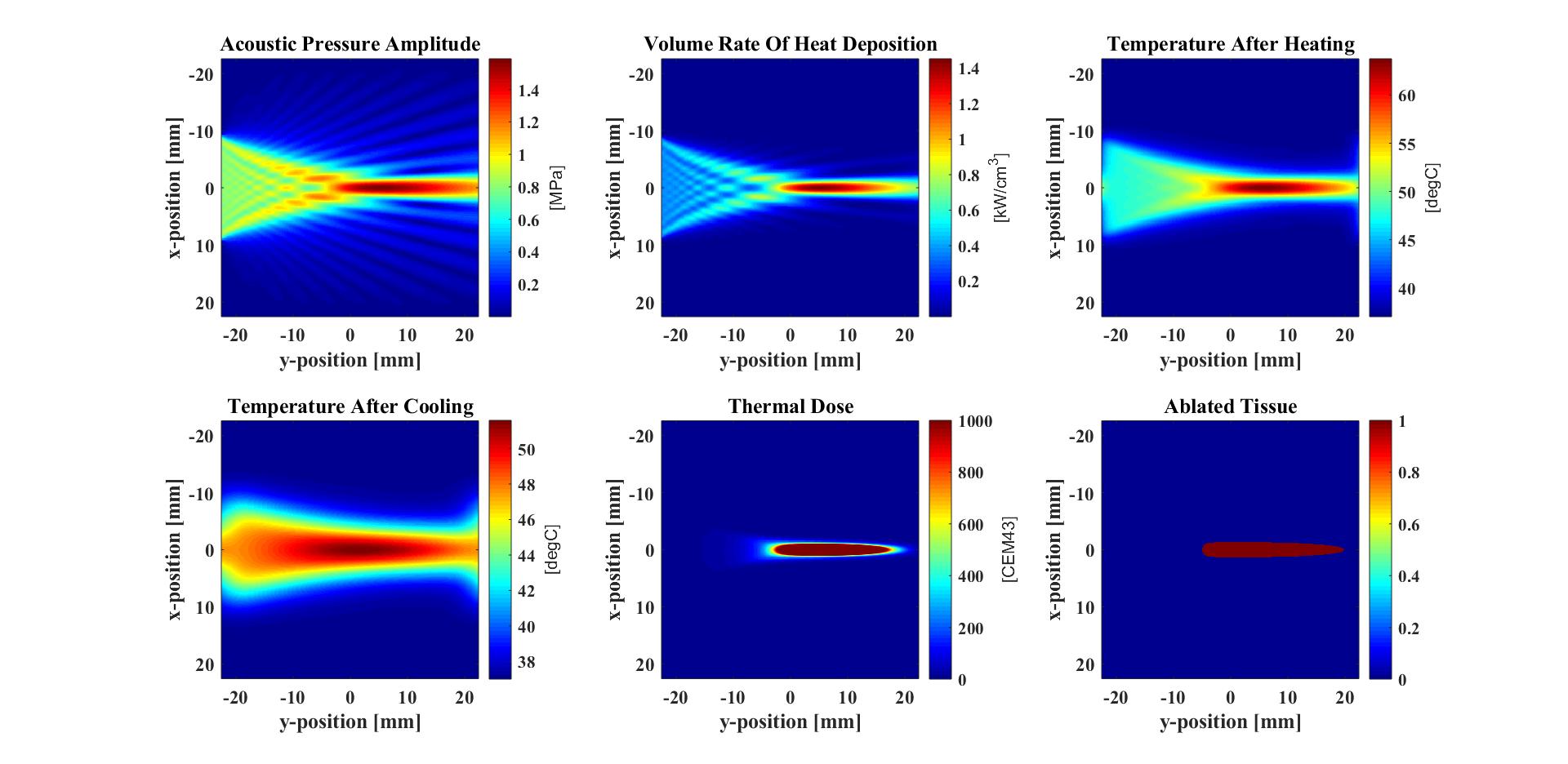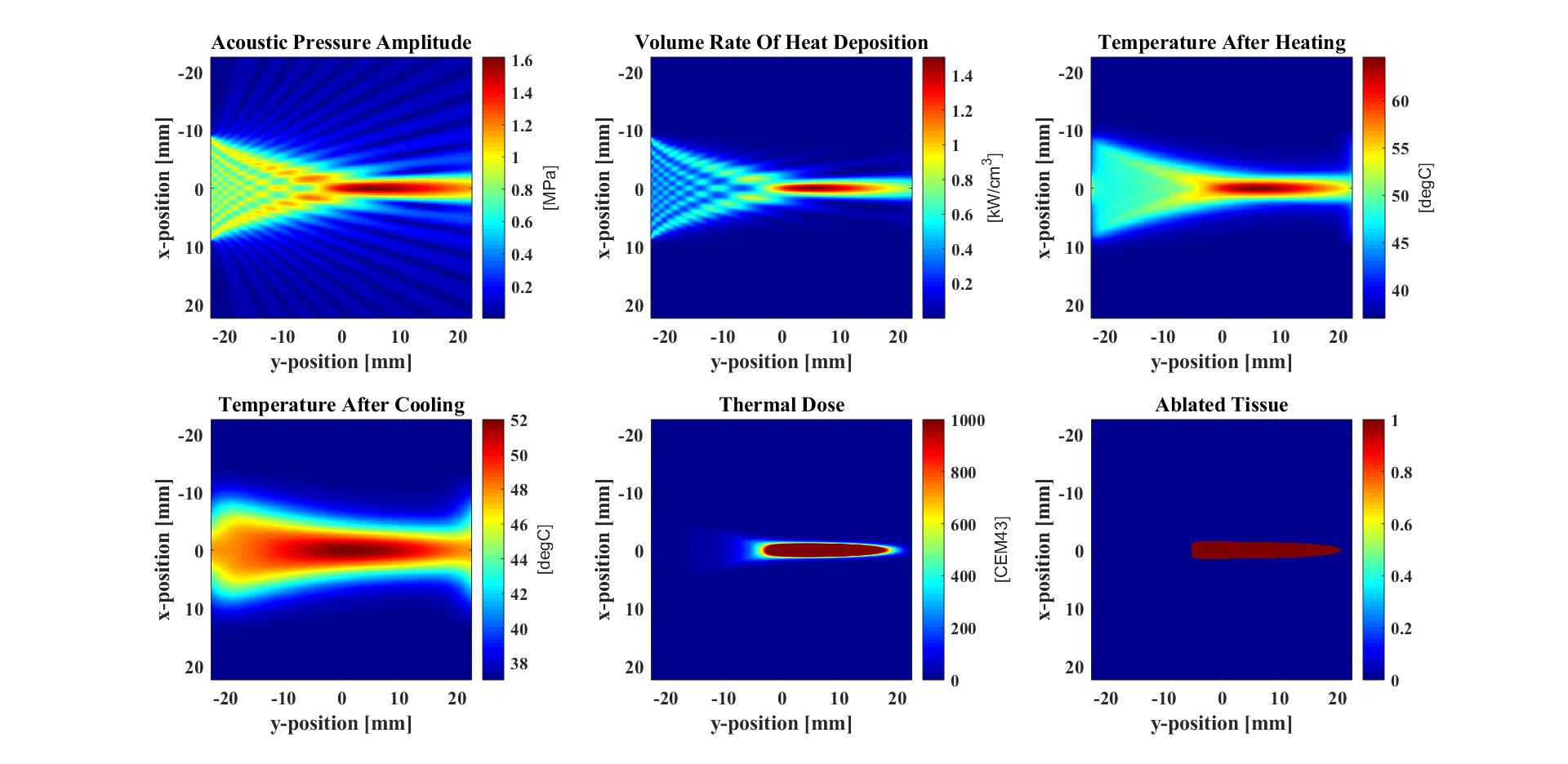Integrating mSOUND with k-Wave for thermal simulations
This example shows how to combine mSOUND and k-Wave for thermal simulations. The acoustic simulation is conducted with mSOUND first and the thermal simulation is subsequently implemented by k-Wave.
Acoustic simulation
The acoustic simulation is first conducted with function Forward2D_fund, to generate the pressure field P_fundamental for the subsequent thermal simulation. In the thermal simulation, the pressure on the source plane will be excluded. Then we need to extract the pressure amplitdue from the acoustic simulation result P_fundamental. The output pressure P_fundamental includes the values at the source plane. In the thermal simulation, the pressure at the source plane will be excluded, otherwise there is a mismatch in the size of the matrices used in mSOUND and k-Wave.
% define the computational domain
x_length = 0.0451; % computational domain size in the x direction [m]
y_length = 0.0450; % computational domain size in the y direction [m]
dx = 1.5000e-04; % step size in the x direction [m]
dy = 1.5000e-04; % step size in the y direction [m]
mgrid = set_grid(0, 0, dx, x_length, dy, y_length);
TR_focus = 0.0360; % transducer focal length
TR_radius = 0.0090; % transducer aperture radius
% calculate the phase delay
delay = sqrt((mgrid.x).^2 + (TR_focus)^2)/medium.c0; % [s]
delay = delay - min(delay);
p0 = 0.8e6; % pressure magnitude at the source [Pa]
fc = 1.0e6; % fundamental frequency [Hz]
omega_c = 2*pi*fc; % angular frquency [rad/s]
source_p = p0*exp(1i*omegac*delay); % define the pulse
source_p(abs(mgrid.x)>TR_radius) = 0;
medium.c0 = 1500; % reference speed of sound [m/s]
medium.c = 1500; % speed of sound [m/s]
medium.rho = 1000; % density [kg/m^3]
medium.beta = 0; % nonlinearity coefficient
medium.ca = 0.75; % attenuation coefficient [dB/(MHz^y cm)]
medium.cb = 1.5; % power law exponent
% non-reflecting layer
medium.absorb_gamma = 0.5;
medium.absorb_alpha = 0.05;
% forward wave propagation
P_fundamental = Forward2D_fund(mgrid, medium, source_p, omega_c, 0, 'NRL');
% extract the pressure amplitude and exclude the values on the source plane
p = abs(P_fundamental(:,2:end));
Thermal simulation
Thermal simulation is conducted with k-Wave.
% convert the absorption coefficient to nepers/m
alpha_np = db2neper(medium.ca, medium.cb) * (omegac).^medium.cb;
% calculate the volume rate of heat deposition
Q = alpha_np .* p.^2 ./ (medium.rho .* medium.c);
% set the background temperature and heating term
source.Q = Q;
source.T0 = 37;
% define medium properties related to diffusion
medium.density = 1000; % [kg/m^3]
medium.thermal_conductivity = 0.5; % [W/(m.K)]
medium.specific_heat = 3600; % [J/(kg.K)]
% create the computational grid
kgrid = kWaveGrid(mgrid.num_x, mgrid.dx, mgrid.num_y, mgrid.dy);
% create kWaveDiffusion object
kdiff = kWaveDiffusion(kgrid, medium, source, []);
on_time = 10; % source on time [s]
off_time = 20; % source off time [s]
dt = 0.1; % set time step size [s]
% take time steps
kdiff.takeTimeStep(round(on_time / dt), dt);
T1 = kdiff.T; % store the current temperature field
% turn off heat source and take time steps
kdiff.Q = 0;
kdiff.takeTimeStep(round(off_time / dt), dt);
% store the current temperature field
T2 = kdiff.T;
The figures below show the acoustic and thermal simulation results. The acoustic simulation is conducted
with mSOUND and the thermal simulation is conducted with k-Wave.
 The figures below show the acoustic and thermal simulation results. Both the acoustic and thermal simulations are
conducted with k-Wave.
The figures below show the acoustic and thermal simulation results. Both the acoustic and thermal simulations are
conducted with k-Wave.

Other examples
·
Simulation of a 2D homogeneous medium using the transient mixed domain method
·
Simulation of a 2D heterogeneous medium using the transient mixed domain method
·
Simulation of a strongly 2D heterogeneous medium using the transient mixed domain method
·
Simulation of a 3D homogeneous medium using the transient mixed domain method
·
Selecting the proper temporal domain size for the TMDM
·
Shock wave simulations with TMDM
·
Simulation of a 2D homogeneous medium using the frequency-specific mixed domain method
·
Simulation of a 2D heterogeneous medium using the frequency-specific mixed domain method
·
Simulation of a 3D homogeneous medium using the frequency-specific mixed domain method
·
Simulation of a 3D heterogeneous medium using the frequency-specific mixed domain method
·
Reducing the spatial aliasing error using the non-reflecting layer
·
Comparing pressure release and rigid boundary conditions
·
Image reconstruction using backward projection
·
Reconstruction of the source pressure distribution with FSMDM in a 3D homogeneous medium
·
Integrating mSOUND with k-Wave for transducers of arbitrary shape
·
Integrating mSOUND with FOCUS for transducers of arbitrary shape
·
Integrating mSOUND with k-Wave for thermal simulations
